Growing peppers indoors is a rewarding and practical way to enjoy fresh, flavorful produce no matter the season. Whether you prefer sweet bell peppers, fiery chilies, or exotic varieties, cultivating peppers indoors allows gardeners to control the environment, optimize growth conditions, and avoid common outdoor pests and unpredictable weather. This guide will provide you with a step-by-step approach, expert tips, and valuable insights to help you achieve thriving indoor pepper plants that deliver bountiful harvests all year long.
Understanding Indoor Pepper Growth
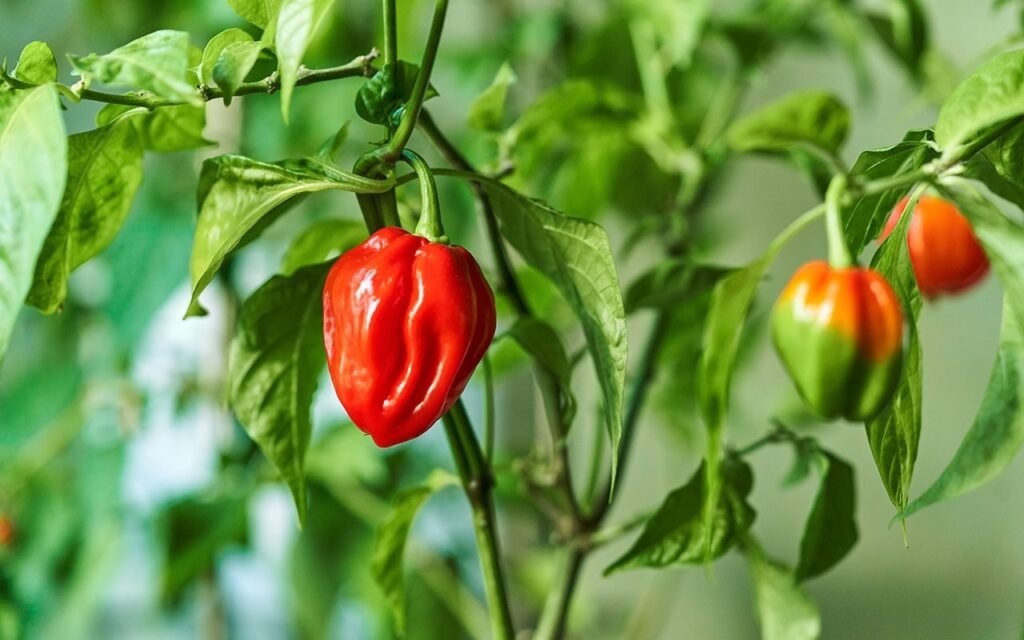
Peppers (Capsicum species) are warm-season crops that thrive in consistent temperatures, adequate light, and well-drained soil. Indoors, these plants can produce just as abundantly as outdoor plants if provided with the right conditions. Key factors that influence growth include light, temperature, humidity, soil quality, watering, and nutrition. Understanding each of these elements is crucial to creating an indoor garden where peppers can flourish.
1. Choosing the Right Pepper Varieties
Not all peppers are equally suited for indoor cultivation. Compact or dwarf varieties are ideal because they remain manageable in pots and produce more fruit relative to their size. Here are some popular choices:
- Sweet Bell Peppers: Compact varieties such as ‘Mini Bell’ or ‘Gypsy’ are perfect for indoor gardening.
- Hot Peppers: ‘Thai Hot’, ‘Cayenne’, or ‘Jalapeño M’ varieties thrive in containers and produce abundant fruit.
- Ornamental Peppers: These are colorful and decorative while also being edible.
Selecting the right variety ensures that your plant’s growth habits match the constraints of indoor space while maximizing yield.
2. Providing Optimal Light
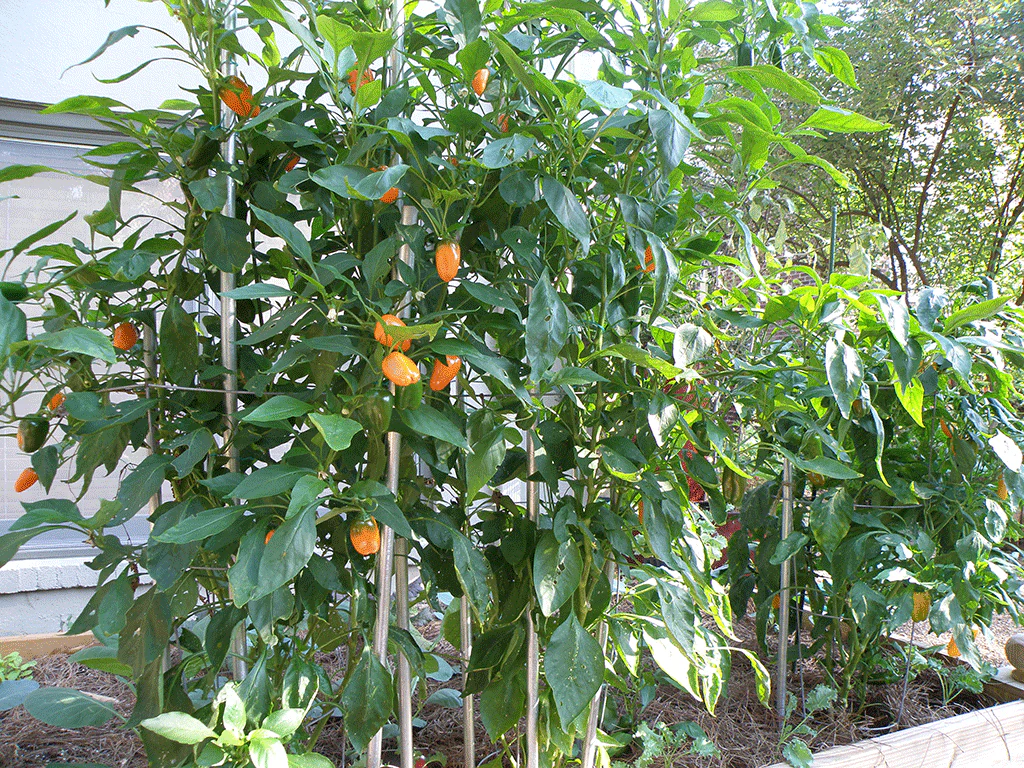
Light is one of the most critical factors for indoor pepper growth. Peppers need 12–16 hours of light per day to photosynthesize and produce fruit effectively. Here are strategies to provide sufficient light indoors:
- Natural Light: Place peppers near south-facing windows where sunlight is strongest. East- or west-facing windows can also work but may need supplemental lighting.
- Artificial Light: LED grow lights are energy-efficient and effective. Position them 6–12 inches above the plants and adjust as the plants grow.
- Light Schedule: Use timers to maintain consistent light exposure, mimicking natural day-night cycles.
Insufficient light leads to weak stems, poor flowering, and reduced fruit production, so investing in proper lighting is essential.
3. Selecting Containers and Soil
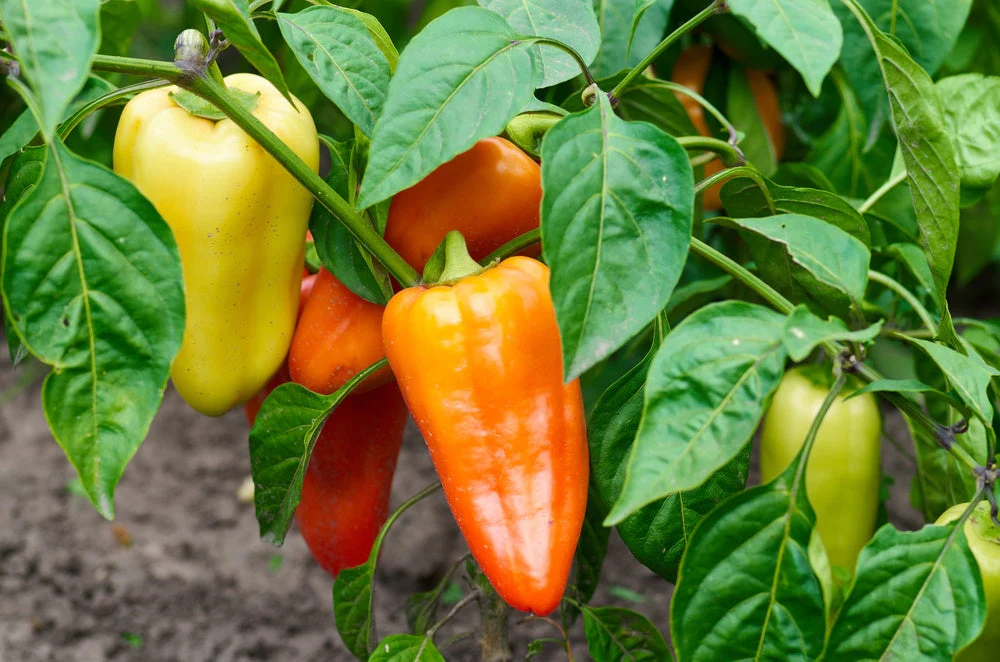
The choice of container and soil significantly impacts root development and plant health.
- Containers: Use pots that are at least 8–12 inches deep for dwarf peppers and 12–18 inches for larger varieties. Ensure the container has drainage holes to prevent waterlogging.
- Soil: A well-draining potting mix enriched with organic matter works best. Avoid garden soil, which can compact and harbor pests.
Good soil and proper drainage reduce the risk of root rot and provide a fertile environment for vigorous growth.
4. Watering and Humidity Management
Peppers need consistent moisture but are sensitive to overwatering. Here’s how to manage it indoors:
- Watering: Water when the top inch of soil feels dry. Overwatering can cause root rot, while underwatering leads to stressed plants and poor fruiting.
- Humidity: Peppers thrive in moderate humidity (50–70%). If indoor air is dry, especially during winter, use a humidity tray or humidifier near the plants.
Maintaining balanced moisture is critical for healthy growth and continuous fruiting.
5. Temperature Control
Peppers are warm-weather plants and are sensitive to temperature fluctuations.
- Ideal Temperature: Keep daytime temperatures between 70–80°F (21–27°C) and nighttime temperatures between 60–70°F (15–21°C).
- Avoid Drafts: Keep plants away from cold drafts, heaters, and air conditioners, which can stress the plants.
- Heat Mats: Seedlings benefit from heat mats to maintain optimal root-zone temperature (around 75°F or 24°C).
Consistent warmth ensures strong vegetative growth and encourages flowering and fruit set.
6. Fertilizing Your Indoor Peppers
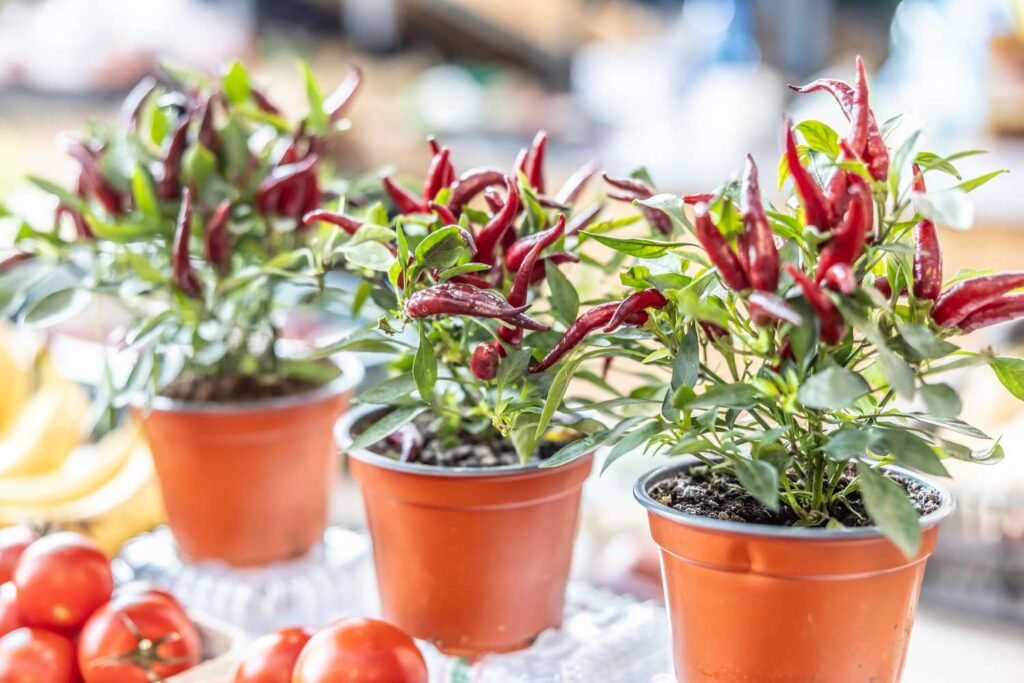
Indoor plants rely entirely on you for nutrients, so regular fertilization is essential.
- Balanced Fertilizer: Use a water-soluble fertilizer with balanced NPK ratios (e.g., 10-10-10 or 20-20-20) for vegetative growth.
- Flowering and Fruiting: Switch to a phosphorus- and potassium-rich fertilizer once flowers appear to promote fruit development.
- Frequency: Fertilize every 2–3 weeks during the growing season. Avoid overfertilizing, which can cause lush foliage but few fruits.
Regular feeding ensures your peppers receive the energy needed for continuous production.
7. Pruning and Plant Maintenance
Pruning encourages bushier growth and better fruiting.
- Pinch Early Growth: Pinch off the top of seedlings once they have 4–6 leaves to encourage branching.
- Remove Dead Leaves: Regularly trim yellow or damaged leaves to prevent disease.
- Support: Some varieties may require stakes or small cages to support heavy fruit.
Maintaining healthy foliage improves airflow, reduces disease risk, and enhances fruit quality.
8. Pollination Indoors
Unlike outdoor plants, indoor peppers may need help with pollination since there’s no wind or insects.
- Hand Pollination: Use a small paintbrush or cotton swab to transfer pollen from flower to flower.
- Electric Toothbrush Method: Gently vibrating flowers can mimic bee activity, improving fruit set.
- Multiple Plants: Growing several peppers increases the chances of cross-pollination and better yields.
Consistent pollination ensures abundant fruit and a continuous harvest.
9. Pests and Diseases
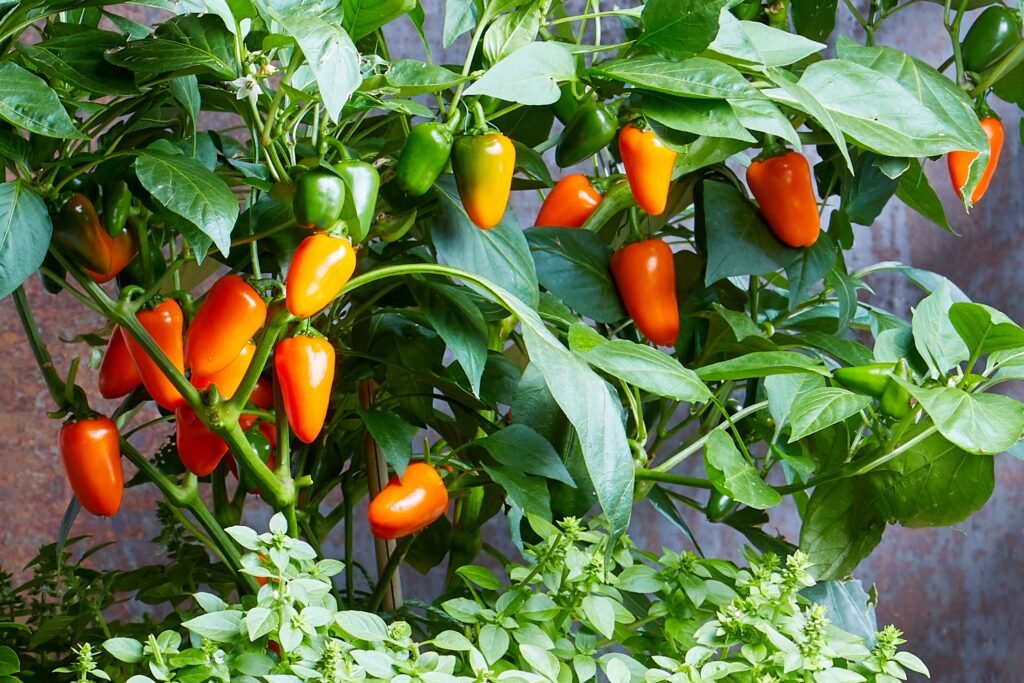
Indoor peppers are less prone to pests than outdoor plants but can still face challenges.
- Common Pests: Aphids, spider mites, and whiteflies can infest plants. Wipe leaves regularly and use insecticidal soap if needed.
- Diseases: Powdery mildew, root rot, and bacterial leaf spot can occur if humidity or watering is mismanaged. Ensure proper airflow and avoid waterlogged soil.
Vigilance and preventive care help maintain healthy, productive plants.
10. Harvesting and Storage
Knowing when and how to harvest peppers ensures the best flavor and continued production.
- Timing: Pick peppers once they reach full size and desired color. Most varieties turn from green to red, yellow, or orange when mature.
- Harvesting Technique: Use scissors or pruners to cut peppers, leaving a small stem attached to avoid damaging the plant.
- Continuous Harvest: Regularly harvesting encourages the plant to produce more fruit throughout the year.
Proper harvesting methods allow you to enjoy fresh peppers continuously.
11. Advanced Tips for Year-Round Production
For serious indoor gardeners aiming for maximum yield:
- Rotate Plants: Maintain staggered planting so that some plants are always producing.
- Climate Control: Use grow tents or dedicated indoor garden spaces to optimize light, temperature, and humidity.
- Hydroponics: Consider hydroponic systems for higher yields and faster growth, as nutrient delivery is more efficient.
By optimizing conditions, you can create a mini indoor farm that provides fresh peppers regardless of season.
Conclusion
Growing peppers indoors is an exciting and rewarding gardening endeavor. With careful attention to light, temperature, watering, fertilization, and maintenance, anyone can enjoy fresh, flavorful peppers year-round. From selecting the right varieties to mastering pollination and harvest techniques, indoor pepper cultivation offers endless opportunities for experimentation and creativity. Whether you’re a culinary enthusiast or simply seeking a steady supply of homegrown produce, indoor peppers can transform your home into a thriving oasis of color, flavor, and nutrition.
By following these steps, you’ll be equipped to cultivate healthy, productive pepper plants indoors—ensuring fresh harvests throughout the year, regardless of outdoor conditions.
